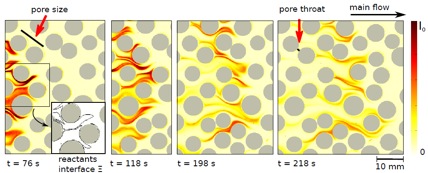Mixing and reaction kinetics in porous media : an experimental pore scale quantification
The mixing of chemical elements and nutrients is a primary controlling process for reactive transport in the subsurface, and consequently for biogeochemical cycles and contaminant transport in subsurface environments. Reaction kinetics measured in well-mixed laboratory reactors are never encountered on the field, and standard models based on Fickian transport/mixing often cannot explain field measurements. This is attributed to the heterogeneity of the pore scale velocity field, and to the resulting subtle interplay between molecular diffusion, heterogeneous advection and reaction at the pore scale. Yet, how this heterogeneity impacts mixing and (reactive) transport processes is still an open question, which we address using a quasi two-dimensional (2D) millifluidic setup. The porous medium consists of a Hele-Shaw cell that contains a single layer of cylindrical solid grains. The setup provides full characterization of the flow and transport/mixing ; from the intra-pore measurement (i) of the velocity field by particle tracking, and (ii) of the concentration field over 3 orders of magnitude. I shall first examine the velocity field, and discuss how Lagrangian velocities can be used to upscale both dispersion and mixing, and obtain predictions that are rather consistent with conservative tracer tests performed in the same porous medium. I shall then consider a configuration in which a solution, A, displaces another solution, B, with which it reacts according to the simple bimolecular reaction A + B → C. Using a chemiluminescent reaction (see the figure below), we have investigated how the reaction kinetics is controlled by the deformation of the mixing zone between A and B. While the classic advection-dispersion theory predicts a scaling of the cumulative product mass of C as time to the power 1/2, we observe two distinct, faster than Fickian, kinetic regimes, corresponding to two deformation regimes of the front between A and B : stretching and coalescence. A theoretical model confirms this interpretation. Many (reactive) transport processes of interest, such as the transport of pollutants from the Earth surface to aquifers, or that of amendments by fluids injected for the remediation of polluted soils, occur in the so-called ’unsaturated zone’, which extends between the Earth surface and the water table. In the last part of the presentation I shall address mixing under unsaturated conditions. We have studied how desaturation induces an anomalous non-Fickian temporal scaling of the global mixing (measured from the scalar dissipation rate) as a consequence of the increasing complexity in the spatial distribution of the solute concentration field.

Spatially-resolved rate of formation of the product C of the reaction A+B → C, measured during the displacement of solution B by solution A in a 2D porous medium.